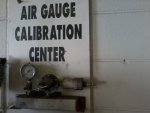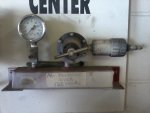- 3,908
- 2,712
- 83
- Location
- Edmonton, Canada
We had a tire pressure gauge fail that allowed an 'over-fill' of 20 psi on an 80 psi tire.
While pouring through Pre-Trip inspections I had one of my 'young guns' grab a tire pressure gauge off the shelf of 10 gauges and help me check the 17 tires carrying us to an airshow this weekend.
While checking a trailer first he decided to look at all the tires before deciding to pull out an air hose.
This trailer had been parked for a few months so when he said everything was down 30psi, I wasn't surprised.
He began to fill the first tire while I re-torqued wheel nuts and did an under chassis inspection. He filled for quite a while, stopping twice to check progress then continued filling. I watched when I stuck my head out from under the truck but he was quiet and appeared to be having success.
He must have had that gut instinct kick in along with the "If you're not sure, don't do it", chime in the back of his head because he stopped and said, "Something is wrong, it is not taking more then 50 psi."
We checked compressor, chuck and air-lines then I asked him to put the gauge on a different tire he knew had been inspected the day before.
Sure enough the gauge only went to 50 psi and stopped. We knew this tire had 80 psi in it yesterday, so we checked another, which also stopped at 50psi. The gauge bar moved freely in and out of the shaft and was rated to 130 psi.
After discarding the tire pressure gauge and grabbing a different one we found he had run the max. 80psi tire to 100psi.
It's been hot and humid here which may have been a contributing factor, along with a cheap gauge and a lack of 'maintaining' the diagnosing device.
I believe we got lucky and the 'splatter factor' was limited. We know the s#!t is going to hit the fan, we just don't know how far it will splatter.
I hope all of you get lucky this weekend as well.
Old video of dyno test tire failure. This one could have been bad with an observer standing next to the tire.
[media]http://www.youtube.com/watch?v=BNB-ZbNpfBA[/media]
Inflating tire failure safety video.
[media]http://www.youtube.com/watch?v=dKlJJqHFfoQ&feature=related[/media]
While pouring through Pre-Trip inspections I had one of my 'young guns' grab a tire pressure gauge off the shelf of 10 gauges and help me check the 17 tires carrying us to an airshow this weekend.
While checking a trailer first he decided to look at all the tires before deciding to pull out an air hose.
This trailer had been parked for a few months so when he said everything was down 30psi, I wasn't surprised.
He began to fill the first tire while I re-torqued wheel nuts and did an under chassis inspection. He filled for quite a while, stopping twice to check progress then continued filling. I watched when I stuck my head out from under the truck but he was quiet and appeared to be having success.
He must have had that gut instinct kick in along with the "If you're not sure, don't do it", chime in the back of his head because he stopped and said, "Something is wrong, it is not taking more then 50 psi."
We checked compressor, chuck and air-lines then I asked him to put the gauge on a different tire he knew had been inspected the day before.
Sure enough the gauge only went to 50 psi and stopped. We knew this tire had 80 psi in it yesterday, so we checked another, which also stopped at 50psi. The gauge bar moved freely in and out of the shaft and was rated to 130 psi.
After discarding the tire pressure gauge and grabbing a different one we found he had run the max. 80psi tire to 100psi.
It's been hot and humid here which may have been a contributing factor, along with a cheap gauge and a lack of 'maintaining' the diagnosing device.
I believe we got lucky and the 'splatter factor' was limited. We know the s#!t is going to hit the fan, we just don't know how far it will splatter.
I hope all of you get lucky this weekend as well.
Old video of dyno test tire failure. This one could have been bad with an observer standing next to the tire.
[media]http://www.youtube.com/watch?v=BNB-ZbNpfBA[/media]
Inflating tire failure safety video.
[media]http://www.youtube.com/watch?v=dKlJJqHFfoQ&feature=related[/media]




